Today Current Affairs: 22nd October 2021 for UPSC IAS exams, State PSC exams, SSC CGL, State SSC, RRB, Railways, Banking Exam & IBPS, etc
Table of Contents
UNEP Production Gap Report:
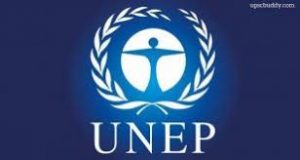
The 2021 Production Gap Report was released by the leading research institutes and the United Nations Environment Programme (UNEP).
- The Production Gap Report, first launched in 2019, tracks the discrepancy between governments’ planned fossil fuel production and global production levels consistent with limiting warming to 1.5°C or 2°C.
- UNEP’s Major Reports: Emission Gap Report, Adaptation Gap Report, Global Environment Outlook, Making Peace with Nature.
Findings of the Report:
- The production gap to achieve the climate goal is the widest for coal: Production plans and projections by governments would lead to around 240% more coal, 57% more oil, and 71% more gas in 2030 than global levels consistent with limiting warming to 1.5°C.
- The most worrying factor is that almost all major coal, oil and gas producers are planning to increase their production till at least 2030 or beyond.
- The production gap has been fuelled by incremental capital flow towards fossil fuels in comparison to clean energy in the post novel coronavirus disease (Covid-19) recovery phase.
- The Group of 20 countries (G20) has channelised USD300 billion to fossil fuels since the beginning of the pandemic, and the sector is still enjoying significant fiscal incentives.
- India’s first NDC (Nationally Determined Contribution), issued in 2016, pledged a 33%-35% reduction in the “emissions intensity” of its economy by 2030, compared to 2005 levels.
- The report quotes a 2020 Government of India press release, to shine a light on India’s plans to raise coal production.
- The government seeks to “unleash the power of coal” and become self-reliant by 2023-24; it also wants to bring about “a paradigm shift in approach from being oriented to maximum revenue from coal to maximum coal available in the market at the earliest.”
- India plans to augment coal production from 730 million tonnes in 2019 to 1,149 million tonnes in 2024.
- India also aims to increase total oil and gas production by over 40% in the same period through measures such as accelerated exploration licensing, faster monetization of discoveries, and gas marketing reforms.
Bhumiputra Bill In Goa:
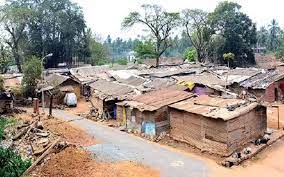
Goa CM has clarified that the Bhumiputra Bill won’t be sent to Governor.
- The Goa Bhumiputra Adhikarini Bill, 2021 that was passed in the Goa Assembly on July 30 had since been at the centre of a political storm.
- The Bill was aimed at giving the status of ‘Bhumiputra’ to a person residing in Goa for at least 30 years and to enable him or her to stake claim to ownership of their house of up to 250 sq m built before April 1, 2019.
- However, activists said that it had hurt the sentiments of the state’s tribal population.
Highlights of the Bill:
- It recognises anyone living in the state for 30 years or more as a ‘Bhumiputra (son of the soil)’ and gives such a person the right to own his or her ‘small dwelling unit’ if ownership was undetermined so far.
- Once recognised as a Bhumiputra, an individual can stake claim to ownership of their house of not more than 250 sq m, built before April 1, 2019.
- The Bill provides for the constitution of the Bhumiputra Adhikarini — a committee consisting of the Deputy Collector as its Chairperson, and officials from the departments of Town and Country Planning, Forest and Environment , and Mamlatdars of respective talukas as its members.
- The Bhumiputra may apply to the committee if his house has been built before the cut-off date.
- The committee will invite objections within 30 days, including from the land owner which could also be a local body, and then take a decision of granting ownership to the Bhumiputra.
- An appeal against the Bhumiputra Adhikarini’s decision can be filed before the Administrative Tribunal within 30 days.
- No court shall have jurisdiction “to entertain, decide or deal with any question which is to be decided by the Bhumiputra Adhikarini and Administrative Tribunal under this Act”.
James Webb Space Telescope:

Engineers have unboxed the James Webb Space Telescope in French Guiana and will now prepare it for launch.
- JWST is one of the grand scientific projects of the 21st Century and will ride to orbit on 18 December.
- JWST is a joint venture between the US (Nasa), European (Esa) and Canadian space agencies (CSA).
- It is an orbiting infrared observatory that will complement and extend the discoveries of the Hubble Space Telescope, with longer wavelength coverage and greatly improved sensitivity.
- Webb was formerly known as the “Next Generation Space Telescope” (NGST) and it was renamed in 2002 after a former NASA administrator, James Webb.
- It will be a large infrared telescope with an approximately 6.5 meter primary mirror
- It will look deeper into the cosmos – and thus further back in time – than is possible with Hubble.
- It will do this with a much bigger mirror (6.5m in diameter versus 2.4m) and instruments that are tuned to the infrared.
- Scientists hope this set-up can detect the light from the very first population of stars in the Universe to switch on more than 13.5 billion years ago.
- The Hubble Space Telescope orbits around the Earth at an altitude of ~570 km above it.
- Webb will not actually orbit the Earth, instead it will sit at the Earth-Sun L2 Lagrange point,5 million km away.
- At the L2 point Webb’s solar shield will block the light from the Sun, Earth, and Moon which will help Webb stay cool, which is very important for an infrared telescope.
Abraham Accords:
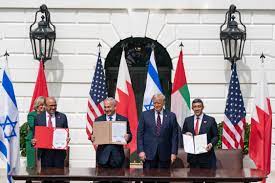
On 18 October, 2021, the foreign ministers of the United States, India, Israel, and UAE met virtually to enhance cooperation and partnerships between these states on the back of the Abraham Accords, signed in 2020, normalising relations between Israel and a grouping of Arab states led by the UAE.
- The Abraham Accords are a joint statement between State of Israel, the United Arab Emirates, and the United States of America, reached on August 13, 2020.
- Subsequently, the term was used to refer collectively to agreements between Israel and the United Arab Emirates (the Israel–United Arab Emirates normalization agreement) and Bahrain, respectively (the Bahrain–Israel normalization agreement).
- The statement marked the first public normalization of relations between an Arab country and Israel since that of Jordan in 1994.
- The agreement with the UAE was officially titled the Abraham Accords Peace Agreement: Treaty of Peace, Diplomatic Relations and Full Normalization Between the United Arab Emirates and the State of Israel.
- The agreement between Bahrain and Israel was officially titled the Abraham Accords: Declaration of Peace, Cooperation, and Constructive Diplomatic and Friendly Relations, and was announced by the United States on September 11, 2020.
- The accords are named after Abraham to emphasize the shared origin of belief between Judaism and Islam, both of which are Abrahamic religions that strictly espouse the monotheistic worship of the God of Abraham.
Kushinagar International Airport:
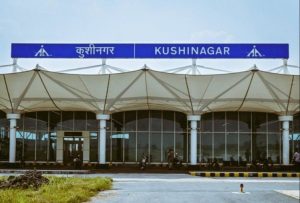
Prime Minister Narendra Modi inaugurated the Kushinagar international airport in the presence of representatives from 12 countries.
- The airport in eastern UP, the third international airport in the state, will mainly service the Buddhist tourism circuit.
- The Sri Lankan Airlines flight carrying monks and dignitaries was the first to land at the airport.
Kushinagar and The Buddha
- Among the most important of Buddhist pilgrimages, Kushinagar was where The Buddha attained Mahaparinirvana (ultimate salvation) in c. 483 BC.
- Today’s Kushinagar is identified with Kushinara, capital of the ancient Malla republic, which was one of the 16 mahajanapadas of the 6th-4th centuries BC.
- The area went on to be part of the kingdoms of the Mauryas, Shungas, Kushanas, Guptas, Harshavardhana, and the Palas. Kushinara is believed to have been inhabited until at least the 12th century.
- The first excavations in Kushinagar were carried out by Alexander Cunningham and ACL Carlleyle, who unearthed the main stupa and the 6-metre-long statue of the Reclining Buddha in 1876.
- Kushinagar is among the very few places in India where The Buddha is depicted in reclining form.
The Sakharov Prize:

Imprisoned Russian Opposition leader Alexei Navalny was awarded the European Union’s top human rights prize in a clear slap to President Vladimir Putin.
- The Sakharov Prize for Freedom of Thought, commonly known as the Sakharov Prize, is an honorary award for individuals or groups who have dedicated their lives to the defense of human rights and freedom of thought.
- Named after Russian scientist and dissident Andrei Sakharov, the prize was established in December 1988 by the European Parliament.
- The first prize was awarded jointly to South African Nelson Mandela and Russian Anatoly Marchenko.
- In awarding the Sakharov Prize to Mr. Navalny, the European Parliament praised his “immense personal bravery”. The 45-year-old activist was poisoned with a nerve agent last year and promptly arrested upon his return to Moscow from treatment in Germany and later imprisoned.
- He has campaigned consistently against the corruption of Vladimir Putin’s regime.
- The recognition of Mr. Navalny will further sour relations between the 27-nation bloc and Russia.
- These ties have been on the decline for years, especially following Moscow’s 2014 annexation of Ukraine’s Crimean Peninsula and its support for a separatist insurgency in eastern Ukraine.
- It comes days after Russia suspended its mission at NATO and ordered the closure of the alliance’s office in Moscow in retaliation for NATO’s expulsion of Russian diplomats.
Mount Manipur:

The Union government rechristened Mount Harriet, a historical tourist spot in the Andaman and Nicobar islands, as ‘Mount Manipur’.
- The announcement was made during Union Home Minister Amit Shah’s visit to Port Blair, where he referred to the “significant contribution” the North-eastern state had made in resisting the British, especially during the historic 1891 Anglo-Manipur war.
- After the Anglo-Manipur War of 1891, several Manipuris who had fought the British in the war, including Maharaja Kulachandra Dhwaja Singh, were exiled to the British penal colony in the Andaman Islands.
- Since the cellular jail (Kalapani) was yet to be built, Kulachandra and the prisoners were kept on Mount Harriet, a hillock in what is now the Ferragunj tehsil of South Andaman district.
- 23 men, including King Kulachandra and his brothers, were “transported for life” to the Andamans.
- The 23 are considered war heroes in Manipur. That is why Mount Harriet is an important symbol of the Anglo-Manipur War of 1891
INSACOG : India SARS-CoV-2 Genome Consortium:
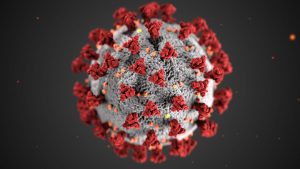
The decline in daily new infections across India has prompted INSACOG (India SARS-CoV-2 Genome Consortium), the consortium of labs focused on sequencing coronavirus variants, to “prioritise” new surveillance approaches.
- In view of currently declining cases and importance of early detection of increased transmission in the future, INSACOG will prioritise developing and expanding a SARS-CoV-2 sewage surveillance program.
- The CSIR-Centre for Cellular and Molecular Biology, which is also part of the INSACOG network, has since early 2020 been collecting sewage from large drains in cities to check for the presence of the virus.
- Because a large fraction of those afflicted by the virus are asymptomatic but are carriers of infection, their body fluids and stool often contain traces of the virus.
- Finding large proportions of it in public drains can often be a precursor to a fresh outbreak, with a rise in symptomatic infections.
- Delta (B.1.617.2 and AY.x) continues to be the main VOC (Variant of Concern) in India. No new VOI (Variant of Interest) or VOC are noted in India.




